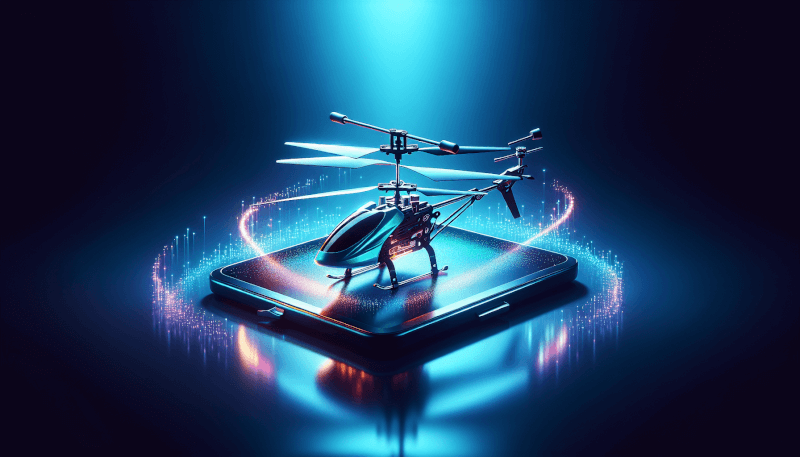So, you’ve finally gotten your hands on your dream RC helicopter and you can’t wait to take it out for a spin. But, before you do, there’s one thing you need to know – how to maximize your RC helicopter battery life. After all, the last thing you want is for your thrilling flight to be cut short due to a dead battery. In this article, we’ll explore some simple yet effective techniques that will ensure you get the most out of your RC helicopter’s battery, allowing you to enjoy longer flights and endless fun in the sky. Get ready to soar high and make every minute count!

Choose the Right Battery
Check the specifications
When it comes to choosing the right battery for your RC helicopter, it’s important to start by checking the specifications. Different helicopters have different power requirements, so you’ll need to make sure that the battery you choose is compatible with your specific model. Look for the recommended voltage and chemistry that your helicopter can handle, as using a battery with the wrong specifications can lead to poor performance or even damage to your aircraft.
Consider the capacity
Another factor to consider when choosing a battery is its capacity. The capacity, measured in milliamp-hours (mAh), determines how long the battery can power your helicopter before it needs to be recharged. If you’re planning on longer flight sessions, you’ll want to opt for a battery with a higher capacity. However, keep in mind that higher capacity batteries are typically larger and heavier, which may affect the overall performance and maneuverability of your helicopter.
Opt for a high-quality battery
To maximize the lifespan and performance of your RC helicopter battery, it’s recommended to invest in a high-quality battery. Cheap and low-quality batteries may not provide consistent power output, leading to poor flight performance and potential safety risks. Look for reputable brands that are known for producing reliable batteries. While these batteries may be slightly more expensive, they are worth the investment in the long run, as they often have better durability and performance.
Look for a battery with low self-discharge
Batteries with low self-discharge rates are ideal for RC helicopters, as they can retain their charge for longer periods when not in use. This is particularly important if you have multiple batteries and rotate them for use. Choosing a battery with low self-discharge means you won’t have to worry about constantly recharging them when you’re ready to fly. Look for batteries that have a low self-discharge rate, typically indicated on the product packaging or specifications.
Perform Proper Battery Maintenance
Avoid overcharging
One of the most important aspects of battery maintenance is avoiding overcharging. Overcharging can lead to reduced battery life and even potential safety hazards. It’s essential to follow the charging guidelines provided by the manufacturer and never leave your battery charging unattended. Once your battery is fully charged, disconnect it from the charger to prevent any further charging.
Use a compatible charger
Using a compatible charger is crucial to maintaining the health and longevity of your battery. Different batteries may have different charging requirements, such as voltage and current. Using a charger that is not designed for your specific battery can result in improper charging and potential damage. Always ensure that you use a charger that is recommended by the battery manufacturer or one that is specifically designed for your battery type and chemistry.
Store batteries properly
Proper storage is key to prolonging the life of your RC helicopter battery. When not in use, it’s important to store your batteries in a cool, dry place away from direct sunlight and extreme temperatures. Avoid storing them in places where they can be exposed to moisture or where they may come into contact with metal objects that can cause a short circuit. Additionally, consider using a battery storage bag or case to protect your batteries from physical damage and accidental discharge.
Ensure proper connection
Ensure that there is a proper connection between the battery and the helicopter’s power distribution system. Loose connections can lead to power fluctuations and inefficient energy transfer, resulting in decreased performance and potential damage to the battery. Before each flight, check the battery connections and make sure they are secure and free from any dirt or debris. Additionally, periodically clean the battery terminals and connectors to maintain optimal conductivity.
Manage Battery Usage
Avoid full throttle all the time
To maximize your battery life, it’s important to avoid flying your RC helicopter at full throttle all the time. Constantly running your helicopter at maximum power puts a significant strain on the battery and can result in shorter flight times. Instead, try to vary the throttle and use it sparingly when necessary. By managing your power usage and incorporating periods of lower throttle, you can extend the overall flight time and reduce the load on your battery.
Use the correct power mode
Most RC helicopters offer different power modes that allow you to adjust the performance and power consumption. When possible, use the appropriate power mode for your flight needs. If you’re just practicing basic maneuvers or hovering, using a lower power mode can help conserve battery life. Save the higher power modes for more demanding aerobatic maneuvers or when you need that extra burst of power.
Avoid excessive weight
Excessive weight can put unnecessary strain on your battery, resulting in decreased flight times and reduced overall performance. Try to keep your RC helicopter as light as possible by minimizing unnecessary accessories and modifications. Avoid adding weighty gadgets or components that are not essential to your flight experience. By ensuring your helicopter is properly balanced and free from unnecessary weight, you can optimize the battery’s performance and extend its lifespan.
Keep the helicopter clean
A clean RC helicopter not only looks good but also contributes to better battery performance. Dirt, dust, and debris can interfere with the moving parts of your helicopter, causing friction and increased power consumption. Regularly clean your helicopter, paying extra attention to the motor, gears, and other components that directly affect power usage. A clean and well-maintained helicopter will require less power to operate, allowing your battery to last longer.
Monitor Battery Levels
Use a battery voltage checker
To accurately monitor your battery levels, it’s recommended to use a battery voltage checker. This device allows you to check the voltage of your battery before and after each flight, giving you a better understanding of its remaining capacity. By keeping a close eye on your battery’s voltage, you can prevent over-discharging, which can lead to irreversible damage. Battery voltage checkers are inexpensive and easy to use, making them an invaluable tool for monitoring your battery’s health.
Check battery levels regularly
In addition to using a voltage checker, it’s important to regularly check your battery levels. A simple visual inspection can give you an idea of how much charge is left in your battery. Many batteries also come equipped with LED indicators that show the remaining charge level. By being aware of your battery’s charge status, you can plan your flights accordingly and avoid pushing your battery to its limits.
Land before the battery depletes
To prolong the lifespan of your battery and prevent damage, it’s crucial to land your RC helicopter before the battery is completely depleted. Flying with a depleted battery can cause voltage drops and result in reduced power output, affecting the helicopter’s performance and stability. Always keep an eye on your battery levels and land your helicopter with enough charge remaining for a safe landing. This practice will not only help maintain your battery’s health but also prevent potential accidents or crashes due to loss of power.

Avoid Extreme Temperatures
Do not expose the battery to extreme heat
Extreme heat can have detrimental effects on your RC helicopter battery. Excessive heat can cause the battery to overheat, accelerating the breakdown of its internal components and potentially leading to reduced capacity and performance. Avoid leaving your battery in direct sunlight or exposed to heat sources such as car dashboards or hot surfaces. If you notice any signs of excessive heat during or after a flight, allow the battery to cool down before storing or charging it.
Do not use the helicopter in extremely cold conditions
Extreme cold can also negatively impact the performance of your RC helicopter battery. Cold temperatures can cause the battery’s chemistry to slow down, resulting in reduced power output and shorter flight times. If you plan to fly in cold conditions, take the necessary precautions to keep your battery warm. Consider using battery blankets or insulating materials to help maintain a stable temperature. It’s also important to allow the battery to warm up to room temperature before charging it, as charging a cold battery can damage its cells.
Consider Battery Upgrades
Upgrade to higher capacity batteries
If you find that your current battery’s capacity is not meeting your flight duration needs, consider upgrading to higher capacity batteries. By opting for batteries with higher mAh ratings, you can enjoy longer flight times before needing to recharge. However, keep in mind that higher capacity batteries may be larger and heavier, potentially affecting the overall performance and maneuverability of your helicopter. Balance your flight time requirements with the size and weight limitations of your helicopter to ensure optimal performance.
Consider lithium polymer (LiPo) batteries
Lithium polymer (LiPo) batteries are a popular choice among RC helicopter enthusiasts due to their high energy density and lightweight design. LiPo batteries offer superior power output and typically have higher capacities compared to other battery chemistries. This translates to longer flight times and better overall performance. However, it’s important to note that LiPo batteries require special care and attention, as mishandling or improper charging can result in safety hazards. If you decide to switch to LiPo batteries, make sure to familiarize yourself with the specific guidelines and precautions recommended by the manufacturer.

Properly Break-In New Batteries
Follow the manufacturer’s instructions
When you purchase a new battery for your RC helicopter, it’s important to follow the manufacturer’s instructions regarding the initial break-in process. Manufacturers often provide specific guidelines on how to properly condition and charge your new battery to ensure optimal performance and longevity. By adhering to these instructions, you can maximize the battery’s lifespan and avoid any potential issues that may arise from improper usage during the initial stages.
Gradually increase usage over time
During the break-in period, it’s recommended to gradually increase your battery usage over time. Start with shorter flight sessions and avoid pushing the battery to its limits right away. By gradually increasing the flight time and intensity, you allow the battery’s internal components to adapt and stabilize, ensuring smoother performance and improved longevity. This gradual approach helps prevent unnecessary strain on the battery, resulting in a longer lifespan and better overall performance.
Balance Charge Batteries
Use a balance charger
To ensure that all cells within your RC helicopter battery are charged equally, it’s important to use a balance charger. Balance chargers monitor and charge each individual cell within the battery simultaneously, ensuring that they reach their full capacity. By balancing the charge across all cells, you prevent imbalances that can lead to reduced performance and potential damage. Choose a balance charger that is compatible with your battery chemistry and follow the manufacturer’s guidelines for proper usage.
Ensure all cells are charged equally
When using a balance charger, always double-check that all cells within your battery are charging equally. This can be easily done by verifying the voltage readings for each cell displayed on the charger’s screen. If you notice any significant discrepancies between the cell voltages, it may indicate an issue with the battery or charger. In such cases, it’s best to stop the charging process and seek further assistance or troubleshooting from the manufacturer or a knowledgeable RC hobbyist.

Reduce Excessive Vibrations
Securely mount the battery
Excessive vibrations can be detrimental to your RC helicopter battery and can affect both performance and overall longevity. To reduce vibrations, it’s crucial to securely mount the battery within your helicopter. Make sure the battery is snugly fitted and properly secured in its designated compartment or battery tray. Consider using Velcro straps or foam padding to absorb vibrations and provide additional stability. By minimizing vibrations, you can maximize the battery’s efficiency and lifespan.
Use vibration-dampening materials
In addition to securing the battery, using vibration-dampening materials can further reduce the impact of vibrations on your RC helicopter. These materials, such as foam tape or rubber mounts, can be strategically placed between the battery and the helicopter’s frame or mounting points. Vibration-dampening materials help absorb and dissipate vibrations, preventing them from reaching the battery and reducing the risk of damage. By incorporating these materials into your helicopter’s setup, you can enhance both battery and overall helicopter performance.
Replace Old or Damaged Batteries
Monitor battery performance
Regularly monitor the performance of your RC helicopter battery to ensure it is still operating optimally. Gradual degradation over time is normal for batteries, but a significant drop in performance may indicate that it’s time for a replacement. If you notice shorter flight times, reduced power output, or difficulty holding a charge, it’s likely that your battery is nearing the end of its lifespan. Keeping track of your battery’s performance allows you to proactively replace it before it fails during a flight.
Replace swollen or damaged batteries
If you notice that your RC helicopter battery has become swollen, bloated, or physically damaged, it’s crucial to replace it immediately. Swelling is a sign of internal damage or internal short-circuiting within the battery, which can pose a serious safety risk. Continuing to use a damaged or swollen battery can lead to overheating, fire, or even explosion. Always prioritize safety and dispose of damaged batteries following your local regulations before replacing them with new ones.



